I wanted to start a new monthly feature on the blog where I share my quick thoughts on new-to-me wargames that Alexander and I played in the previous month. These are not new release games, in fact, some of them are nearly 10 years old, but they have evaded us to date robbing us of the opportunity to enjoy these older gems!
In our world today, it is easy to get distracted by the bright and shiny. Easy to get caught up in the hype of the cult of the new. Heck, I even write a monthly post that deals with all of the NEW games that have been offered up for pre-order and/or which are now available for purchase called Wargame Watch. We like new stuff! But, with this post, I want to try to show you how older is sometimes better.
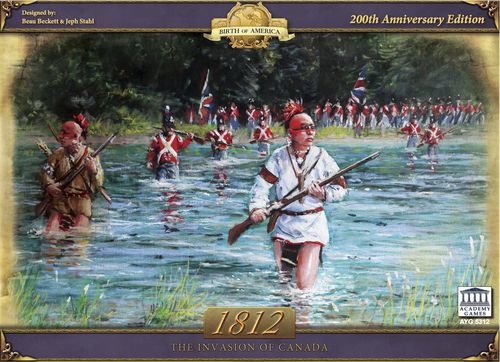 1812: The Invasion of Canada (2012) from Academy Games
1812: The Invasion of Canada (2012) from Academy Games
I actually acquired this game in a trade earlier this year and am really glad that I did as I love the history (and Academy Games does a great job of including lots of additional insight into the history behind the game) and the fact that this game is a very lite wargame that could be considered a family game. After playing 1775: Rebellion several years ago, as well as 878: Vikings last fall (see my posts Action Point 1 and Action Point 2), when playing 1812: The Invasion of Canada I remembered that I liked the system used in this game quite a bit. The game uses area movement on a board that represents the Great Lakes region of the United States and lower Canada with Objective Areas, including key cities and forts, identified with stars. The goal of the game is for the players to own the most Control Markers on the board. Control Markers are placed when an enemy Home land territory is invaded and controlled. Simple as that.
Players will control one or several of 5 different factions, including British Regulars, Canadian Militia, Native Americans, American Militia or American Regulars. If played as a 2-player game, one player will control the British Regulars, Canadian Militia and Native Americans (the British Alliance) while the other player controls the American Militia and Regulars (Americans). Each faction has a deck of cards that contain Movement cards, Special cards and 1 Truce card.
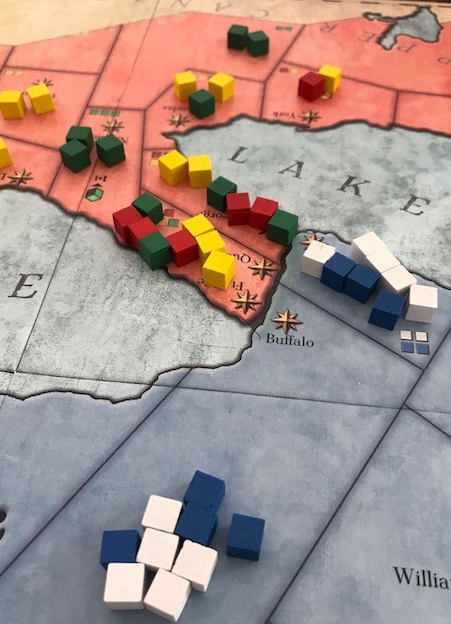
The active player must play one Movement Card, even if the only one he has is a Truce card, and can play up to two Special cards per turn. This won’t happen often though as there are only 4 Special cards in each deck.
These Movement cards typically identify a number of different Armies that can be activated, this does vary by faction but is typically 1-4 Armies, along with a specific number of spaces that they can then move, typically 1-3 spaces. Armies are groups of units located in the same area and can consist of units from different allied factions.
There are also special water movement cards, including Canoes and Fishing Boats. The Canoes allow 5 Native American units, from up to 5 different areas on the same body of water, to move to one single area on the same body of water. Fishing Boats allow two armies, of up to 3 units each, and from up to two different areas, to move to one single area on the same body of water. These water movement cards can be very powerful and can bring a lot of force against a single space.
The really cool element to the management of your cards is that you will have the one Truce card for each of your factions, which must be used wisely, as it can lead to the end of the game when you don’t necessarily want it to end. You see, once an alliance has played all of their factions’ Truce cards, the game will end at the end of that turn. Remember, you may have to play a Truce card from your hand if it is the only Movement card that you drew so you must be careful, especially as the Americans, as you can prematurely end things before you have had an opportunity to place the most Objective Markers on the board as you only have 2 Truce cards as compared to 3 for the British alliance.
The combat system is also really simple and asymmetrical as each faction has a unique set of dice that they will use in combat. The 6 sided dice each have a different number of the various symbols on them. The target equates to a hit and will mean your enemy must remove one of their units. A running man means that your units were rattled during combat and will flee to the Fled Units box where they can be placed again in a future round as a part of your scheduled reinforcements. The blank side of the dice is a Command Decision and allows for the rolling player to retreat a single unit to an adjacent friendly controlled location. This is most important when you are vastly outnumbered and have no chance of winning. You might as well run away to fight another day than die in bloody hail of musket balls!

Finally, I really liked the activation mechanic. Each faction has a blank plastic cube in their color which are all thrown into a cloth draw bag. Players then reach into the bag and blindly draw one of the cubes out and that player then gets to play their cards, activate their units and fight their battles. Once their turn is completed, another cube is drawn and that player takes their actions. Pretty simply mechanic that adds some tension to the design. The real trick with the activation is that each side will be watching the order with great interest, especially once the game has passed round 3, as after that the game can end if factions have played all of their Truce cards. This becomes very strategic as to when you go and frankly I like to go last in a round because I feel that I have control, especially as the Americans once at least one of their 2 Truce cards are played. This can lead to some really great tension as players count and recount their number of placed Control Markers trying to make sure they have the most as the last player takes their turn.

Overall, we really enjoyed our play of 1812: The Invasion of Canada. There are lots of neat elements to the design, but overall it is a simple lite wargame that can be played in about 90 minutes. Bravo to Academy Games as there Birth of America Series games are really interesting yet have some good strategy to them.
Hearts and Minds: Vietnam 1965-1975 (2010) from 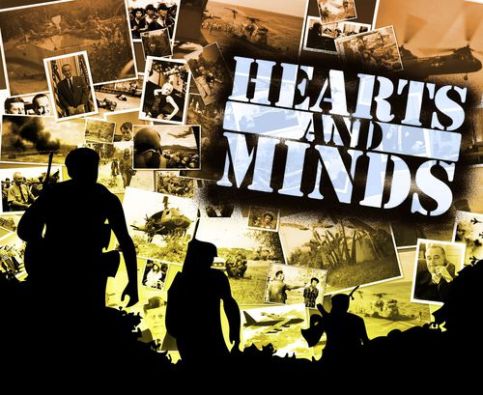 Worthington Games
Worthington Games
We really enjoy Card Driven Games and try to play as many of them as we possibly can get our hands on. We also enjoy Vietnam wargames. So, when we had a chance to play a CDG on the Vietnam War, it was a no brainer! I got this game for Christmas and it was a used copy of the 1st Edition. There is a 2nd Edition out there and I really don’t know what the differences are. But recently there was an announcement from Compass Games of a 3rd Edition release and it looks really good. But that is neither here nor there.
In Hearts and Minds: Vietnam 1965-1975 players will play as either the US/ARVN forces (with some units from NATO as well as ROK) against the Communist forces which include NVA regulars and VC hidden units. The game has multiple scenarios and covers the entirety of the Vietnam War from 1965 all the way through 1975 as the U.S. forces left and only the ARVN remained to attempt to stem the red tide coming down into South Vietnam.

Players have a hand of 5 cards each round from which they will play 4 that provide Resource Points to perform various actions including activating units to move up to their movement allowance, attacking enemy units, doing bombing missions, pacifying areas or forcing a political change. Each faction has their own deck, the Communist deck is red, the Allies is blue and then there are black cards that are neutral. Players will make their decks from their color and mix in half of the black cards. These cards represent the meat of the game and are the vehicle to make the game progress. The Resource Points are spent to perform the actions mentioned above and also can be used to buy the printed event on the card just played. Sometimes this event will have lasting effects for the entire game, such as the Commando Hunt card that allows Bomber missions to target Laotian border provinces and also allows more than 1 bomber to bomb any given province, or will have a one time effect such as Junction City, that allow you to spend more than one saved Resource Point in a given turn as long as all Battle and PC- Change actions take place in Zone III. These cards are well done and the game boils down to the efficient use of the hand that you are dealt. Sometimes, you will be given cards with high RPs of 4 or 5, which will allow you to make a lot of progress with various actions including moving forces, battling the opposition and making political changes. But, there will be times when your draws are not great and you have a hand full of low value RP cards but they might have interesting and very useful events that you must take advantage of. In essence, you have to play the cards you are dealt and make the best go of things. This can be both fun and frustrating but always keeps things interesting and required that you plan and execute on that plan.

Battle is pretty simple as well as all the counters are pretty much the same for both sides. Each counter has an untried side and a veteran side (with either a 1-6 or 2-6 for ARVN and US troops or a 1-4 or 2-4 for NVA and typically a 1-1 for VC units) and then there are support units such as mortars, artillery, tanks and helicopter gunships. When a players units are located in a province with enemy units, a contested area is created where the players can fight by buying a battle round for the cost of 1 RP. If they battle doesn’t conclude, another battle round can be purchased with an additional RP until the player no longer has RPs. Units in a province simply total up their battle factors (located in the bottom left corner of the counters), roll a die and consult his specific faction’s Battle Table. The results are the damage that must be applied and fire is considered simultaneous. The results include a specific number of units that must be eliminated but also sometimes has a capital R that means the player must either lose one unit or pay a saved RP. The blue table is slightly better than the red table, but not by much.
The really neat part about the battles is that units can evade before the battle starts with a roll, which becomes more difficult in certain terrain types and also has negative results for even attempting, such as the loss of a unit. This part can be very frustrating for the Allied player as he has finally corned the wily NVA and VC and they then slip right through his fingers with a favorable roll.
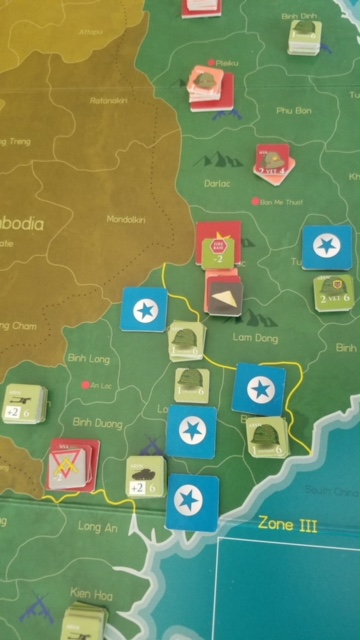
How does the game end? Well, players will be fighting each other for control of provinces and for casualties that will affect the will of the fighting powers and adjust the Political Will Track. This track factors in how each side feels about the war and their attitude to continued hostilities. Each scenario has a set level for an immediate victory, which frankly will never happen, and an end scenario number, which is more reachable. The Political Will Track really sums up the game for me and the feelings that many had about the Vietnam War. It seemed that escalation of bombing, more U.S. Troops on the ground and bloodshed didn’t equate to a victory. But simply meant the fighting would linger until one side or the other eventually would give in. I recommend this game wholeheartedly for anyone that likes CDGs and for anyone that is interested in a holistic approach and treatment of the Vietnam War. As I mentioned, there is a 3rd edition printing in the works from Compass Games and I definitely am interested as my 1st edition copy and its components need some work. My only negative about this game is that it appears to be very hard for the Communists to win. That is probably an assessment after only one play as we both really didn’t know what we were doing but it is a concern of mine that I would like to see in future plays.
Conflict of Heroes: Awakening the Bear! – Operation Barbarossa 1941 2nd Edition (2012) from Academy Games
We love tactical games and have played quite a few of them, but Conflict of Heroes has never graced our table, until Alexander recently acquired Awakening the Bear! 2nd Edition in a trade. The Conflict of Heroes series is designed as a fast playing and simplified tactical wargame. But please don’t be fooled by my use of the word “simplified”, because this game has strategy and depth and really was a joy to play. In the game players control individual squads and tanks to play out the various tactical engagements that characterized the Eastern Front of World War II. Players will have to make tough decisions about how best to use their men, how best to utilize their Activation Points to maximize their benefit, while also being flexible to respond to actions by the enemy player.
The game includes units that represent infantry squads of between 6-12 men, including crewed support weapons such as mortars and individual vehicles such as armored cars and the big guns as well including many types of tanks. The counters in this game are large and very well done with the perfect amount of information and detail that adds to the flavor and theme of the game while keeping it easy to play.
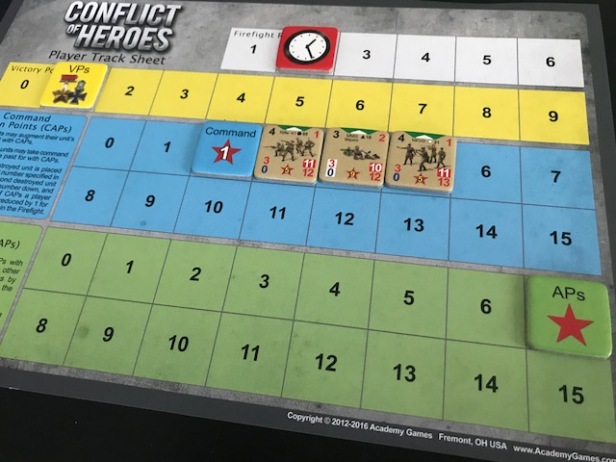
A round consists of a series of alternating activations by each player. During this activation, a player can take one action, stall (simply do nothing and surrender your turn to the other player) or pass after all of your units have used their Action Points. An action is simply any single thing that a unit can do, including attacking, moving, pivoting your facing, rallying, etc. Each of these actions will cost a number of Action Points (APs). The key is that the Active unit has to either spend all of their APs before moving to activate another unit or they will sacrifice them. This is one of the keys to the system and is really cool. It creates a mini economy that you have to manage properly in order to get the most out of your units. This system also creates some “cat and mouse” games between the players as your enemy may activate a unit across the board, that is threatening an objective or other units, and you must decide how you will react. You can use limited a limited Opportunity Action with another fresh unit, but understand that will be it for that unit as it will be marked Spent, or you can sacrifice any remaining APs on your currently activated unit to activate a unit across the board to deal with this new threat.
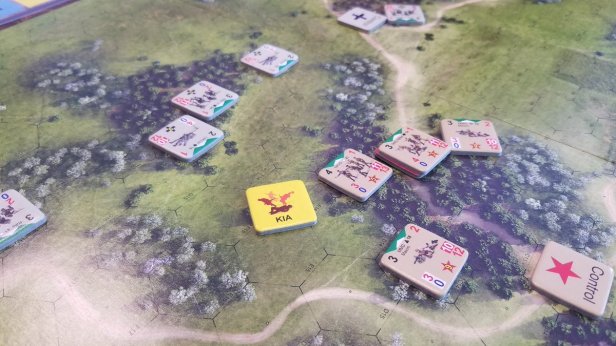
The combat system is pretty cool as well and includes some very familiar mechanics used in other tactical games that we have played. In order to take an attack action, a unit must not have a condition on them that prohibits attacks and there is a simple formula that is followed. The player takes the firing unit or units Attack Rating (if there is a firing group, you identify a main firing unit and then each adjacent unit activated for the attack will add +1 to the AR) and then rolls 2d6 to come up with their total attack value. Players can also use available Command Points to add a +1 modifier to an attack but these CPs are rare commodities and should be preserved for big actions. This Attack Value is then compared to the Defense Value of the target unit and includes either their front or flank values (flank is usually 1-2 points less) as well as any terrain modifiers or placed fortifications. If the Attack Value meets or exceeds the Defense Value, the unit is hit and now we move to the fun part….the Hit Marker draw!

There are a total of 20 Hit Markers that are drawn blindly from a cup and not revealed to your enemy but are viewed by the drawing player and then placed under the counter of the unit that took the hit. These Hit Markers are varied and include conditions such as Suppressed, which grants +1 to the cost for attacks, Stunned, which negates the units attack and move ability and then there is the dreaded KIA counter, which immediately eliminates that unit. There is only 1 KIA counter out of 20 so it will not be drawn often but as more and more units are hit and have a Hit Marker underneath their counters rather than in the cup, the chances of drawing it are increased! It always seems to be drawn 3-4 times a game and can be very dramatic. Normally, it requires two Hit Markers to eliminate a unit.
There are lots of other elements to the game, including Action Cards, Bonus Cards, tanks, tanks and more tanks! I will be doing a few Action Point posts on the game over the next few weeks so I will stop my comments here. Suffice it to say, we really enjoyed the game and look forward to playing it again in the near future. We are also very interested in the Storms of Steel and Guadalcanal expansions and hope to acquire them in the near future.
Flames of War: Open Fire! Starter Set (2012) from  Battlefront Miniatures
Battlefront Miniatures
Both Alexander and I enjoy miniature games and have played many different themes and styles. We really enjoy Tactical Miniatures in games such as Conan from Monolith Editions and Star Wars: X-Wing from Fantasy Flight Games. But, when Alexander bought the Flames of War: Open Fire! Starter Set in December 2016, I was immediately hooked on historical miniatures as he began to paint these fantastic minis that include Paratroop units, Sherman Tanks, StuGs, Panzers and more. Flames of War is a two player table top miniatures game. It’s put out by a company called Battlefront Miniatures based out of New Zealand and is a 15mm scale WWII historical game. You’ll command a force typically the size of a company and fight to the death for control of objectives or other mission parameters determined by various scenarios. The ‘Open Fire!’ starter set is everything you need to get started within a single box and this is what we played.
 The rules were pretty good but were laid out in a weird way, kind of like a comic strip, but they had decent player aids and we figured the rules out pretty quickly. It really is pretty simple once you get the basics down. This was our first real tabletop miniatures wargame. As I mentioned, we’ve played some X-Wing and Star Wars Armada, but nothing on this scale. One of the things we really liked about the starter set was that it doesn’t try to overwhelm you with all of the systems mechanics and units but instead teaches you enough and exposes you to different aspects where you have a feeling of being fulfilled. The starter set includes armor, lots of Shermans, including Fireflies, StuG IIIs, Panzer III’s and a few other odds and ends liked anti tank guns and mortars. Infantry are also a big part of the game and are designed to do the dirty work or assaulting positions and rooting out opposition so the tanks have targets to shoot. I loved playing the US Paratroopers as they had a mortar team to rain fire on the dug in Germans and a bazooka team to get shots off at those damn StuGs.
The rules were pretty good but were laid out in a weird way, kind of like a comic strip, but they had decent player aids and we figured the rules out pretty quickly. It really is pretty simple once you get the basics down. This was our first real tabletop miniatures wargame. As I mentioned, we’ve played some X-Wing and Star Wars Armada, but nothing on this scale. One of the things we really liked about the starter set was that it doesn’t try to overwhelm you with all of the systems mechanics and units but instead teaches you enough and exposes you to different aspects where you have a feeling of being fulfilled. The starter set includes armor, lots of Shermans, including Fireflies, StuG IIIs, Panzer III’s and a few other odds and ends liked anti tank guns and mortars. Infantry are also a big part of the game and are designed to do the dirty work or assaulting positions and rooting out opposition so the tanks have targets to shoot. I loved playing the US Paratroopers as they had a mortar team to rain fire on the dug in Germans and a bazooka team to get shots off at those damn StuGs.
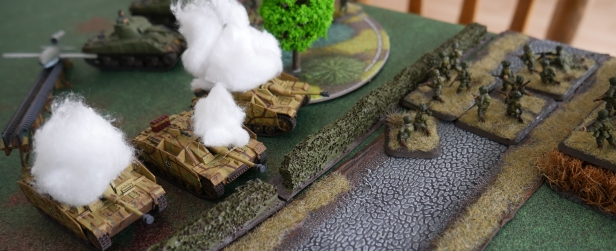 The scenario we played took us about 2 hours and involved 6 turns. The game ended with my Paratroopers unable to capture the V-2 Rocket launcher, shown in the pictures above, but I was able to knock out the control building located to the left of the launcher by assaulting the Pak-40s and German grenadiers there. All in all, a great time and Alexander has done such a nice job of painting the minis and putting the terrain together, most of which was homemade. You can check out our video review after our first play to get a better feel for the game. In the end, this is a game that we highly recommend for anyone looking to break into the miniatures world. Just make sure you can paint or have the money to pay someone to do it as you will thank yourself after the experience is over.
The scenario we played took us about 2 hours and involved 6 turns. The game ended with my Paratroopers unable to capture the V-2 Rocket launcher, shown in the pictures above, but I was able to knock out the control building located to the left of the launcher by assaulting the Pak-40s and German grenadiers there. All in all, a great time and Alexander has done such a nice job of painting the minis and putting the terrain together, most of which was homemade. You can check out our video review after our first play to get a better feel for the game. In the end, this is a game that we highly recommend for anyone looking to break into the miniatures world. Just make sure you can paint or have the money to pay someone to do it as you will thank yourself after the experience is over.
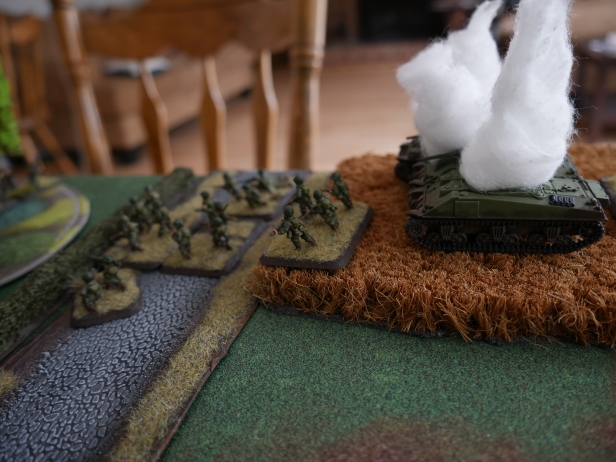
There you have it, our first post in a new series, as we play through older games that we have either just discovered or have had in our collections for some time gathering dust. In the June edition, which will come out the first week or so of July, we have already played a classic block wargame from Columbia Games called Wizard Kings that we really enjoyed and will discuss as well as are trying to get in a play of Band of Brothers: Ghost Panzer from Worthington Games and The Pacific War: From Pearl Harbor to the Philippines from Lock ‘n Load Publishing.
-Grant

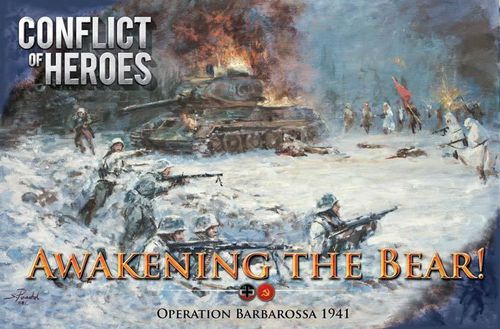
Love this new feature.
LikeLike
I’m glad you enjoyed it. I am trying to give my thoughts but not go so in-depth as I would with a normal review. Just quick and dirty so you can see how the games play and what they are about. Should be a blast to do each month! Thanks for reading.
LikeLike
Some great games on this list that stand the test of time!
LikeLike
Definitely! We had a great time playing them. They were mostly lighter but there is nothing wrong with that. Sometimes you just want a game that plays in 90 minutes. Don’t get me wrong, we love a long marathon like our Holland ’44 9 hour session a few months ago, but short and sweet is also good. Thanks for reading!
LikeLiked by 1 person
What a great article! Thanks a lot😉
LikeLiked by 1 person
Thanks. I’m glad you liked it. Have you played any of those games?
LikeLike
Just Conflict of Heroes: Awakening the Bear!, but thanks to your article I am already waiting for 1812: The Invasion of Canada and Hearts and Minds too. Look forward to future articles.
LikeLiked by 1 person
Good to see a “New to Me” fellow traveler to my cult. 🙂
And some great-sounding games too!
LikeLiked by 1 person
I have to admit I borrowed your idea. I thought it was a good one and the response to the post has been very good which means I will continue it into the future. Thanks for the idea Dave!
LikeLiked by 1 person
That makes me very happy! Both that you borrowed my idea and that you will keep it going.
Look forward to future articles.
LikeLiked by 1 person